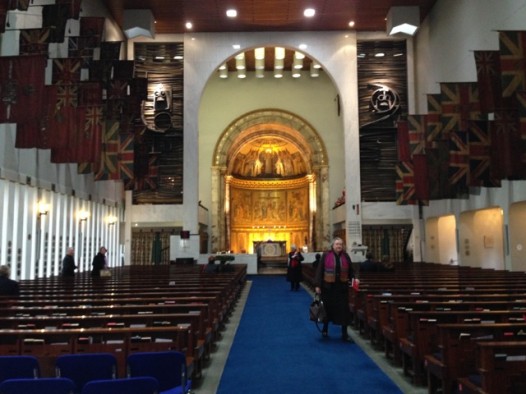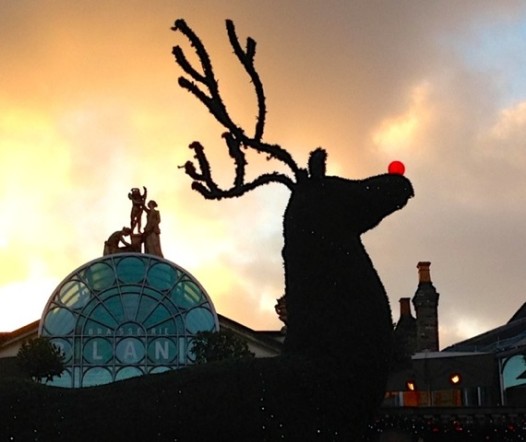
Regimental flags, dramatic sculpture and the surviving 1838 apse at London’s contemporary Guards Chapel. Photo credit, Millie Ball.
As November rolled effortlessly into December, my wife, Millie, and I found ourselves in one of the most dramatic and evocative spaces I know, the Guards Chapel, for Sunday service in London.
Officially known as the Royal Military Chapel, St. James Park, religious home to the Queen’s Household Guard in Wellington Barracks, the minimalist 1963 chapel, which incorporates remains of the radiant 1838 mosaic-encrusted apse that survived wartime bombing during a morning service, is replete with history and imagery.
Regimental flags, spanning several centuries and reminiscent of those in New Orleans’ Civil War Museum, line the sidewalls, leading to monumental, metal sculptures on either side of the restored apse. The dark, stark, twisted elements reference the devastation of the bombing, and the two monumental, plaintive faces memorialize the 120 who died in the rubble.
Yet, on Sunday, December 1, 2013, the first Sunday of the month, the chapel seemed more like a village church, as ladies of the congregation offered coffee, miniature mince pies and ginger snaps to those who lingered in the narthex after service.
“Can it be? It’s December already,” commented a lavender-overcoated woman as she poured me coffee. “Isn’t that lovely?”
I had to respond. “Just think,” I offered philosophically, “when we went to bed last night, it was November, and without the least bit of effort on our part, we woke up in December.”
“Jolly good,” her companion replied. “Yes, you’re so very right. No effort at all.”
So very British. So civilized. Ever so polite. Yet so amusing. All we needed was Dawn French, in her role as the often-flummoxed minister Geraldine in the British comedy series, The Vicar of Dibley, to complete the scene.

Rudolph joins the Neo-Classical figures atop London’s Covent Garden market on a picture-perfect December afternoon. Photo credit, Millie Ball.
We followed our visit with a walk through Covent Garden, where an immense topiary Rudolph lifted his shining nose skyward, towering over the restored market halls.
Back on this side of the Atlantic, the end of the month brought the sad demise of iconic Louisiana artist George Rodrigue, whose passing was celebrated last week in a service at St. Louis Cathedral that echoed that of Lindy Boggs and other celebrities, and was the equal for pomp and circumstance of the Guards Chapel and its military brass band.
Although known for his Blue Dog paintings, Rodrigue’s artistic legacy, rather than his celebrity, may one day be recognized as his early paintings of life and legend in Acadiana, which always seemed to take place in deeply brooding silence, under spreading oaks at dusk.
These were the paintings that my family displayed in Madewood’s Carriage House in 1973 for the New Orleans Opera’s Fete Champetre, the first opera ball, when Rodrigue was a young, relatively-unknown artist from Southwest Louisiana. Some of those works later materialized in John Folse’s Lafitte’s Landing restaurant, at the foot of the Sunshine Bridge in Donaldsonville.
I am guilty of asking to be moved from a table at Criolla’s, a restaurant near Florida’s renowned Seaside community, nearly twenty years ago, because it faced a small early Blue Dog painting that made me uneasy. The image seemed mechanical and threatening at the same time — a little like Freddie in the Nightmare on Elm Street movies; and, though I did not realize it way back then, perhaps that was its enduring power over the public. Maybe, deep down, the Blue Dog wasn’t really that lovable after all.
But at Thursday’s memorial service, Archbishop Gregory Aymond unwittingly raised a question of great doctrinal consequence to the Catholic Church, a matter of greater import than Pope Francis’ initiative to serve the poor and more demanding of prayer and soul-searching than the Vitter family’s Dark Night of the Soul, during Thanksgiving, over whether or not the pater familias should run for governor in 2015.
When Rodrigue approached the pearly gates, longtime nola.com/Times-Picayune chronicler John Pope quoted the Archbishop as saying, “I suspect that he offered God a Blue Dog painting.”
More troubling was a comment by Pope, the reporter, that other speakers “speculated that Blue Dogs have been turning up in heaven.”
But Catholic doctrine holds that animals do not go to heaven, so what’s a poor Cajun artist to do?
I would simply advise the Archdiocese to place a large Blue Dog sculpture in front of Notre Dame Seminary, just in case the Blue Dog’s alter ego, the fearsome French werewolf, the loup garou of Acadiana, comes calling.
 NOLAbeings Multimedia artist Claire Bangser created NOLAbeings as a portrait-based story project that marries...
NOLAbeings Multimedia artist Claire Bangser created NOLAbeings as a portrait-based story project that marries...  Voodoo in New Orleans: Reviving history: New Orleans fortune telling This article takes a deep dive into the history of Voodoo in New Orleans, its hybridization with Catholicism, and its present-day place in the city's culture. The author visits fortune-tellers in the French Quarter, using their guidance as a tool for introspection rather than a deterministic predictor of the future. Through her experiences in New Orleans, the author feels a mystical connection to both the past and the future.
Voodoo in New Orleans: Reviving history: New Orleans fortune telling This article takes a deep dive into the history of Voodoo in New Orleans, its hybridization with Catholicism, and its present-day place in the city's culture. The author visits fortune-tellers in the French Quarter, using their guidance as a tool for introspection rather than a deterministic predictor of the future. Through her experiences in New Orleans, the author feels a mystical connection to both the past and the future. 